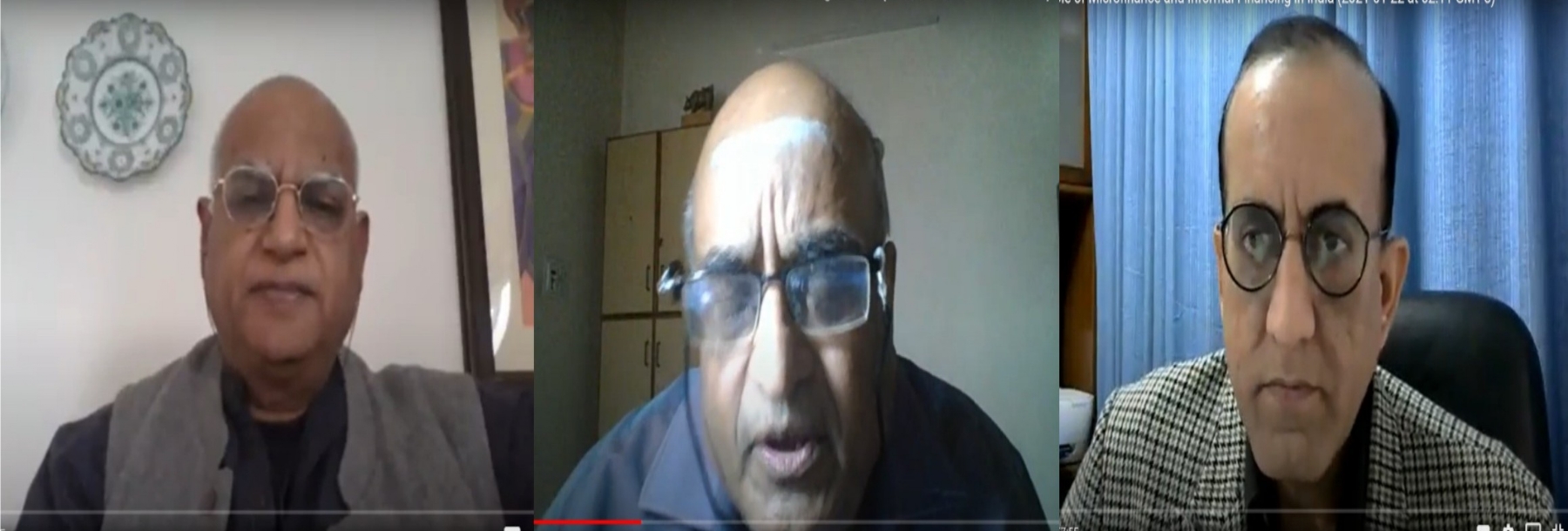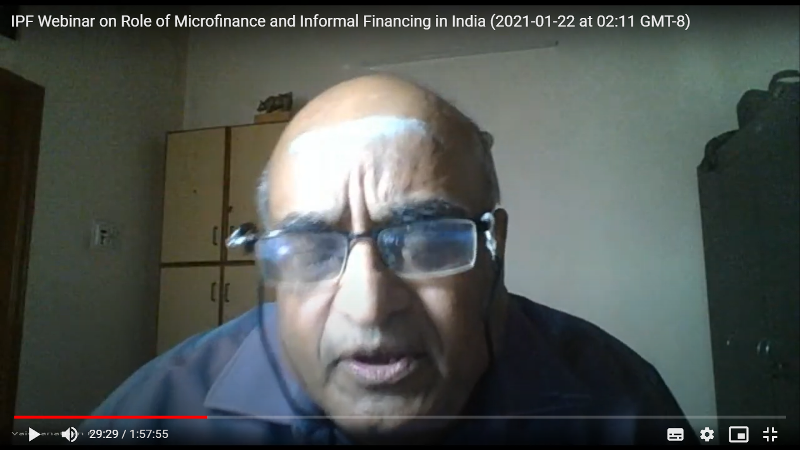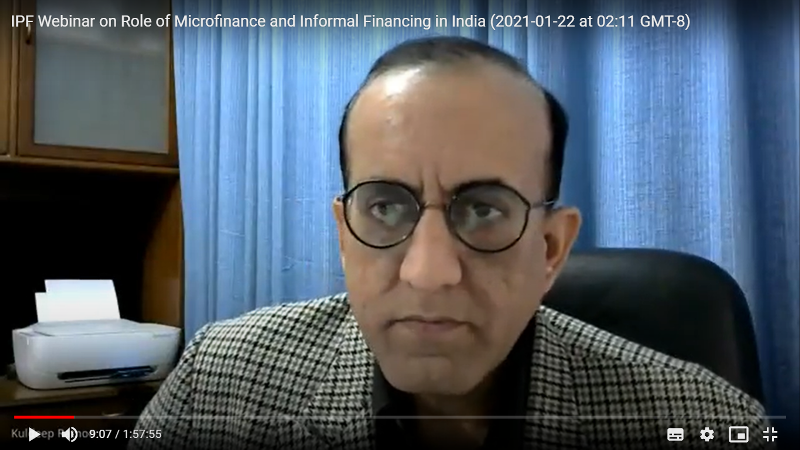Microfinance and Informal Financing in India
Total Views |
IPF Webinar
on
Microfinance and Informal Financing in India
January 23, 2021

High job growth possible by strengthening informal financial sector, say experts
In a webinar on Microfinance and Informal Financing, experts from the financial and development sectors observed that since formal financial institutions do not extend help to the needy poor, unemployed people and struggling enterprises, there is an urgent need to encourage informal financing by integrating it into a liberal formal system.
“The growth path for the Indian economy which will ensure high GDP growth rate as well as high employment growth rate is rural and non-rural non-farm self-employment,” said Shri Vijay Mahajan, social entrepreneur and incumbent Director, Rajiv Gandhi Institute for Contemporary Studies. He was speaking at the webinar organised by India Policy Foundation on Microfinance and Informal Financing in India.

Elaborating on the topic, he said, “Since 2000, we have been facing this issue of jobless growth. The incremental addition to the workforce was not getting absorbed productively. We have roughly 47 crore workers of which roughly four crore are unemployed. Of the 43 crore who work, almost 50 per cent are self-employed. They either work in farms or in micro-enterprises.
Giving the example of China, he said, China managed to move nearly 10 core people to small scale town and village enterprises in the period 1989-1999. He opined that India needs to make a similar transition from agriculture to non-farm livelihoods and self-employment.
He pointed out that there are not enough jobs in the Indian economy for all the increment in the labour force to be employed and villages cannot be the growth centres for non-farm growth due to issues like economies of scale.
He observed that when there is such widespread unemployment in the country, the only available option is to become a private entrepreneur, for which some access to capital is required. Since formal banking sector is unable to extend help to the needy millions, informal financing play a role. He added that it is a misconception that money lenders are exploitative and it needs to be kept in mind that money lenders are managing with whatever little they have. Traditional moneylenders have not become filthy rich in spite of generations involved in this activity.
He said, “The access to capital will not come from financial institutions. Hence microfinance is important for the most important national goal we have which is to ensure high GDP growth with high level of job growth.”
Prof. R. Vaidyanathan, banking and finance expert, who retired as Professor of Finance from IIM, Bangalore, took the discussion forward and said, “85-90 per cent of the businesses in India do not depend on any formal financial institution. They all depend on local efforts, extended family, caste members, money lenders and various other things like chits.”
 He observed that the structure of Public Sector Banks is very peculiar with varying responsibilities. They are not meant for the development of the market. To substantiate his point, he mentioned that multiple studies have found that almost 70 per cent of a branch manager’s time is spent on daily administrative matters and there is not much time to look at the catchment issues.
He observed that the structure of Public Sector Banks is very peculiar with varying responsibilities. They are not meant for the development of the market. To substantiate his point, he mentioned that multiple studies have found that almost 70 per cent of a branch manager’s time is spent on daily administrative matters and there is not much time to look at the catchment issues.He opined that the role of money lenders is important and it is necessary to integrate into the formal financial system. He suggested that a way of doing this is by creating MUDRA Bank which can rate the moneylenders and refinance them. He termed the existing regulations as “bizzare” which do not permit a moneylender to borrow money. He added that the figures of small loans turning into Non-Performing Assets are much less in comparison to corporate loans.
Making an interesting observation, he said, “Approximately, 16 per cent of our GDP is collected through direct and indirect taxes. Another 15 per cent of our GDP is in bribe money collected by individual employees of the government. Most of this bribe money goes into financing small businesses. Source of funds is clearly the illicit money collected by the government officials because of which nobody wants a check on these kinds of financial systems. So, if you have to break out of this vicious cycle, you have to integrate them in the formal system.”
To help the “unincorporated enterprises” run smoothly, he suggested to keep all government regulations aside for three years. He pointed out that to set up a small shop in Bangalore, 21 regulations are required at present. This becomes impossible for anyone to follow all these regulations and the entrepreneurs end up bribing the officials. He added that all these regulatory requirements can be made self-certified for a period of three years.
Dr Kuldeep Ratnoo, Director, India Policy Foundation who moderated the session observed that banks are becoming more conservative as far as giving loans are concerned. He said, “Formal finance is very difficult even for the professionals working in metros, if they are employed by small entities, not included in the database of commercial banks. Naturally, it is far more difficult for the poor and unemployed to get finance from formal banking system”

In the discussion that followed, Shri Mahajan agreed with Prof Vaidyanathan and said that India requires a simple law which states that regulations will not apply to entities employing only family members. He opined that such a step will take care of 86 per cent of the seven crore enterprises.
However, he also warned that it is important to have a more nuanced view about regulation as they are necessary. The crux should be that regulations should not be applied with equal intensity to transaction of all sizes.
He reiterated that micro finance borrowers are a very secure asset class and pointed to many studies that prove this. He said, the issue of non-payment has flared up only when there was a politically motivated interference or there was a serious natural calamity. He pointed out that even in those cases, the repayment rates return to normal in two-three months. Giving the example of the pandemic situation, he said the repayment rates had returned to 90 per cent by the end of July as for poor people, maintaining their credit worthiness is important.
However, on the suggestion to establish a MUDRA Bank, Shri Mahajan said, “If the MUDRA Bank is going to be another Public Sector Bank (PSB), then we have a problem. But if we could come up with a plan where the MUDRA Bank does not have the limitations of a PSB, but has government backing. One solution could be to ensure that there are at least 25-40 small finance banks (SFB).”
Pointing to a study conducted by the Labour Bureau, of almost one lakh MUDRA loans, he said an interesting fact that emerged from the report is that the employment generated per enterprise and also per lakh of rupees borrowed was higher for the categories for loan amounts of Rs2 lakh to 20 lakh. He stressed that considering this, the banks should finance loans in this range, instead of giving smaller amount.
“Loans that come under the Shishu category (loan amount below Rs 50 thousand) do not generate jobs. These only sustain the subsistence job of the person taking the loan,” he said.
Suggesting a solution, he said, there is a need for large number of new enterprises to come up. “There should be slight tweaking to the MUDRA loan categories and there should be loans available for small enterprises,” he added.
“New enterprises by definition means start-ups and globally the success rates for start-ups rarely exceed 30-40 per cent under the best of circumstances. So, if we want to generate 5 crore jobs through one crore enterprises each generating five jobs, then we will have to promote three crore enterprises, sadly out of which two crore would fail. So, the question is how we, as a nation, deal with the start-up failure at such a huge level,” he asked.
“Further, if the failure rate is going to be two thirds, then no lender can ever break even in any conceivable interest rates. If 66 per cent of the money that a lender has given is going to sink, then the lending rate will have to be 75 per cent for him/her to break even and that will not be acceptable to anybody.”
“Therefore, as a solution, these will have to be financed through micro equity venture capital.” However, he pointed out that what is missing in India is a regulatory framework to make this happen.
“Right now, we have a very peculiar law which disallows people from giving loan to anybody or putting money in someone’s bank account, other than their close relatives. This law needs to be corrected and we should encourage both partnership finance and Person to Person (P2P) financing. They will bring together borrowers and lenders. About five years ago, the RBI had created a regulatory framework for P2P financing. India should have a few hundred P2P companies,” he said.
Elaborating further, he said, all of this needs to be facilitated using technology. He brought attention to the fact that currently India has 41.6 crore bank accounts that are accessible through mobile phones. This is in addition to completely digitised banking and a generation that is very comfortable with technology.
“If we put all this together, we can now create a financing platform which is low cost, transparent and accountable,” he opined.
Citing the example of the Rs 21,000 crore worth scam through nefarious Chinese apps, he stressed that there needs to be due diligence and failure in two or three cases should lead to improving the technology than shutting down the entire structure.
Prof Vaidyanathan once again brought attention to the need that instead of too much centralised regulations, banks should themselves be asked to regulate most of their activities.
“We require large number of financial institutions, not few big banks, and less regulation but very effective regulation and punishment for deviation should be swift and severe,” he said in his concluding remarks.